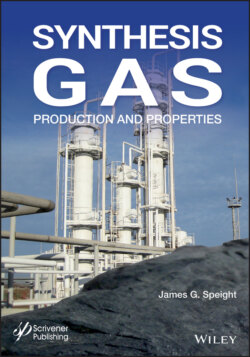Читать книгу Synthesis Gas - James Speight G., James G. Speight - Страница 38
2.3.7 Black Liquor
ОглавлениеAnother waste that is not often recognized as a source of energy – in the current context a potential source of synthesis gas – is the waste from pulping processes. As an example, black liquor is the spent liquor from the Kraft process in which pulpwood is converted into paper pulp by removing lignin and hemicellulose constituents as well as other extractable materials from wood to free the cellulose fibers. The equivalent spent cooking liquor in the sulfite process is usually called brown liquor, but the terms red liquor, thick liquor, and sulfite liquor are also used. Approximately seven units of black liquor are produced in the manufacture of one unit of pulp (Biermann, 1993).
Black liquor is the spent liquor from the Kraft process in which pulpwood is converted into paper pulp by removing lignin and hemicellulose constituents as well as other extractable materials from wood to free the cellulose fibers. The present-day chemical pulping process uses a complex combustion system called a recovery boiler to generate process heat and electricity as well as to recover the processing chemicals in an almost closed cycle. The recovery boiler is a very complex device, which is actually operated as a gasifier-combustor. After evaporation of the majority of the water, the very high solids black liquor is sprayed onto a mass of char in the bottom of the boiler. Black liquor comprises an aqueous solution of lignin residues, hemicellulose, and the inorganic chemical used in the process and 15% w/w solids of which 10% w/w are inorganic and 5% w/w are organic. Typically, the organic constituents in black liquor are 40 to 45% w/w soaps, 35 to 45% w/w lignin, and 10 to 15% w/w other (miscellaneous) organic materials.
The organic constituents in the black liquor are made up of water/alkali soluble degradation components from the wood. Lignin is partially degraded to shorter fragments with sulfur contents in the order of 1 to 2% w/w and sodium content at approximately 6% w/w of the dry solids. Cellulose (and hemicellulose) is degraded to aliphatic carboxylic acid soaps and hemicellulose fragments. The extractable constituents yield tall oil soap and crude turpentine. The tall oil soap may contain up to 20% w/w sodium. Residual lignin components currently serve for hydrolytic or pyrolytic conversion or combustion. Alternative, hemicellulose constituents may be used in fermentation processes.
Gasification of black liquor has the potential to achieve higher overall energy efficiency as compared to those of conventional recovery boilers, while generating an energy-rich synthesis gas. The synthesis gas can then be burned in a gas turbine combined cycle system (BLGCC – black liquor gasification combined cycle – and similar to IGCC, integrated gasification combined cycle) to produce electricity or converted (through catalytic processes) into chemicals or fuels (e.g., methanol, dimethyl ether, Fischer-Tropsch hydrocarbon derivatives and diesel fuel).
The organic constituents in the black liquor are made up of water/alkali soluble degradation components from the wood. Lignin is partially degraded to shorter fragments with sulfur contents in the order of 1 to 2% w/w and sodium content at approximately 6% w/w of the dry solids. Cellulose (and hemicellulose) is degraded to aliphatic carboxylic acid soaps and hemicellulose fragments. The extractable constituents yield tall oil soap and crude turpentine. The tall oil soap may contain up to 20% w/w sodium. Lignin components currently serve for hydrolytic or pyrolytic conversion or combustion. Alternative, hemicellulose constituents may be used in fermentation processes.
In another aspect, lignin pyrolysis produces reducing gases and char which react with the spent pulping chemicals to produce sodium carbonate (Na2CO3) and sodium sulfide (Na2S). Other minerals in the feedstock appear as non-usable chemical ash and have to be removed from the cycle. The gas product from the char bed passes to an oxidizing zone in the furnace where the gas is combusted to produce process steam (and electricity) as well as provide radiant heat back to the char bed for the reduction chemistry to take place. The product chemicals are molten, drained from the char bed to collectors, and then poured into water to produce green liquor.
Thus, the pulp and paper industry offers unique opportunities for the production of synthesis gas insofar as an important part of many pulp and paper plants is the chemicals recovery cycle where black liquor is combusted in boilers. Substituting the boiler by a gasification plant with additional biofuel and electricity production is very attractive, especially when the old boiler has to be replaced. The equivalent spent cooking liquor in the sulfite process is usually called brown liquor, but the terms red liquor, thick liquor, and sulfite liquor are also used. Approximately seven units of black liquor are produced in the manufacture of one unit of pulp (Biermann, 1993).
